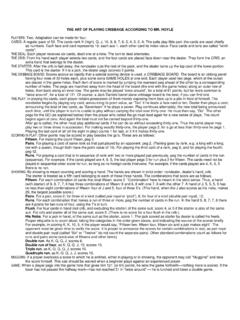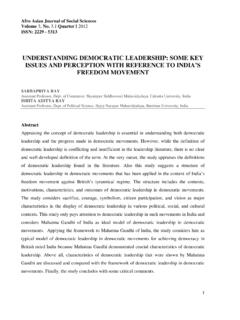Transcription of Ars Notoria - Ancient Code
1 A. RS. N otoria The NOTORY Art of Solomon Translated from Latin into English B y Robert Turner, 1657. Ars Notoria : The Notary Art of Solomon Translated by Robert Turner, 1656. Transcribed and converted to Acrobat by Benjamin Rowe, July 1999. Foreword copyright 1999 by Benjamin Rowe Typeset in Adobe Caslon Foreword At the present time, there is only one English version of the Ars Notoria ; all cur- rently-available editions of the book are based on the translation done in the 1650's by Robert Turner, a student of magical and astrological texts. Turner translates a Latin version published by Agrippa fifty years earlier. While many earlier Latin versions are referenced by scholars some from as early as the 13th century no one has as yet taken the time to produce an updated English rendition of the work, or to fully com- pare Agrippa's version with the earlier versions. The foundation and essence of the practices described in the Ars Notoria lies in the figures or notes that give it its title.
2 These consist partly of realistic illustrations, partly of sigils and signs similar to other grimoires of the day, and partly of text, which winds into and around the graphical elements. When used as objects of contemplation (or in a more active use of visual imagination) the notes are said to place the user's mind in a state in which it is granted complete knowledge or skill in one of the seven Liberal Arts. Unfortunately, Turner's translation did not include these figures. Photographs of several notes can be found in Visual Art in Two Manuscripts of the Ars Notoria , by Michael Camille, published in Conjuring Spirits: Texts and Tradi- tions of Medieval Ritual Magic, edited by Claire Fanger, published by the Pennsylva- nia State University Press. According to Dr. Fanger, there are at least three stylistically distinct sets of notes to be found among the Latin manuscripts of the Notoria . No one set is considered definitive. The text instructs the practioner to look into or inspect the note with which he is working several times a day, and to recite certain prayers and magickal names during a portion of those occasions.
3 The specific prayers and names are integrated into the visual portion of the note in some instances, and it is not known whether these integrated prayers are among the many translated by Turner. What is actually meant by inspect is obscure. The Latin word, inspicio, has essentially the same range of meanings as the modern English word; none of them are informative in the context. But the text mentions several times that visions are a part of the process of use, without explaining exactly how they are involved; and the section quoted below suggests that something more than close examination is intended. And know this; that if thou hast not the books in thy hands, or the faculty of looking into them is not given to thee; the effe of this work will not be the lesse therefore: but the Orations are twice then to be pronounced, where they were to be but once: And as to the knowledge of a vision, and the other virtues which these Holy Orations have; thou maist prove and try them, when and how thou wilt.
4 So it would seem that a specific skill or ability is involved, a faculty of inspec- tion . Perhaps this was simply the ability to memorize the image and visualize it i while reciting the orations. The monk John of Morigny, who practiced the Ars Noto- ria to some effect, later used such visualization in his own system of religious magic. Such techniques were generally known at the time, from various systems for improv- ing the memory. Or possibly the technique was similar to those used by modern magicians to obtain a vision related to a specific symbol, by using it as a gate in the imagination, and entering into an astral world that embodies the meaning of the symbol. In any case, the author of the Notoria seems confident that one can get by without such skill if necessary; the Prayers alone, said with sufficient fervor and rep- etition, will produce the same results. The book is divided into three sections. The first of these deals with what the author calls generals ; these are abilities of broad application memory, eloquence, understanding and perseverance which need to be developed before the practitioner works to obtain the particular skills of one of the Liberal Arts.
5 These latter he refers to as the specials . The section mixes commentary with prayers that are to be used to obtain the abilities, in a manner that is somewhat difficult to follow. (It should be noted that only an abbreviated form of some prayers is given. ). The second section deals with the specials , giving prayers in sequence for each of the Liberal Arts, in the order in which they were customarily taught. The Notes all relate to this section of the book; each prayer is accompanied by instructions on the use of the proper note, and some small amount of commentary. The third section presents some prayers that were allegedly given to Solomon at a different time than those of the previous sections. However, most of these prayers are those already referenced in Part I, save that they are given here in full. The focus of this section is again on the generals , though the technique described varies in some respect from those previously given. Dr. Fanger and others have speculated that this section was a variant of Part I, which perhaps had originally been circulated sep- arately, and later incorporated in the Ars Notoria for its greater detail.
6 None of these sections are clearly distinguished in the text, which can lead to a great deal of confusion as instructions in one section seem to conflict with those in another. The start of each section has therefore been marked by a footnote. The text of this edition was transcribed directly from a photocopy of Turner's first edition, published in 1657. Even by the standards of the time, the book was not a great example of the typographer's art; it was cheaply printed, and was clearly typeset by three different people, each with their own notions of what constituted good text layout, and of what constituted proper spelling of English. For the overall layout of this edition, I have selected elements from each of their styles, but use them consis- tently throughout the text. The punctuation, and the spelling, capitalization and emphasis of individual words have been left as in the original. The exception is that I. have not followed the 17th-century practice of substituting the letter f for s , believing that doing so would greatly reduce the readability of the text.
7 The errors that have crept into recent printed editions (particularly the edition issued by the ii Holmes Publishing Group) are not present, although no doubt there are new errors of my own devising. Several elided passages have been restored. Two additional articles present in the 1657 edition are not included here. The first of these, A Certain Magnetick Experiment, describes a device for long-distance communication based on an imaginary property of magnetized iron. The second, An Astrological Catechisme, is a translation of a Latin document by Leovitius, partially rewritten by Turner. It presents a series of questions and answers concerning astrol- ogy and its practice. Benjamin Rowe June 30, 1999. iii Ars Notoria : THE. NOTORY ART. OF. SOLOMON. Shewing the CABALISTICAL KEY. {. Magical Operations Of The liberal Sciences Divine Revelation, and The Art of Memory. Written originally in Latine, and now Englished by Robert Turner London, Printed by F.}
8 Cottrel, and are to be sold by Martha Harison, at the Lamb at the East-end of Pauls, 1657. The First Note of Grammar 2.. The Epistle Dedicatory. To his Ingenious and respe ed friend Mr. William Ryves, of St. Saviours, South- wark, Student in Physic and Astrology. SIR. q he deep inspe ion and dove-like piercing Eye of your apprehension into the deepest Cabinets of Natures Arcana's, allures me (if I had no other attra ive Magnetic engagements,) to set this Optic before your sight: not that it will make any addition to your knowledge; but by the forti- tude of your judgment, be walled against the art-condemning and virtue-despising Calumniators. I know the candour of your Ingenuity will plead my excuse, and save me from that labour; resting to be Your real affe ionate Friend, Robert Turner. Little Britain, die , in , 1656. 3.. To the Ingenious Readers. ^. mongst the rest of the labours of my long Winter hours, be pleased to accept of this as a flower of the Sun; which I have transplanted from the copious Roman banks into the English soyle; where I hope it will fruitfully spread its branches, and prove not a perishing gourd, but a continual green Laurel, which Authors say is the plant of the good Angel, and defends all persons near its shade from the Penetrating blasts of Thunder and Lightening, so will this be a flower fit for every mans Garden; its virtues will soon be known, if Practised, and the blasts of vice dispersed: its subject is too sublime to be expressed.
9 Let not the carping Momi, nor envious black-jaw'd Zoili rayl; let not the ignorant bark at that which they know not; here they learn no such lesson: and against their Calumnies, the book I thus vindicate: quod potest per fidem intelligi, & non aliter, & per fidem in eo operare potes. [illegible Greek quotation1], &c., Heb. 11. &c., and my own intention I thus demonstrate; Dico coram omnipotenti Deo, & coram Jesu Christo unigento Filio ejus, qui judicaturus est vivos & mortuous;. quod omnia & singula quae in hoc opere dixi, omnesque hujus Scientiae vel artis pro- prietates, & universa quae ad ejus speculationem pertinent, vel in hoc Volumine con- tinenter, veris & naturalibus principiis innituntur, fuintque cum Deo & bona Conscientia, sine injuria Christiame fidei, cum integritate; sine superstitione vel Idololatria quacunque, & non dedeceant virum sapientem Christianum bonum atque fidelem; Nam & ego Christianus sum, baptizatus in nomine Patris, &c.
10 Quam fidem cum Dei auxilio quam diu vixero firmiter inviolatam tenebo; Procul ergo absit a me, discere aut scribere aliquid Christianae fidei & puritati contrarium, sanctis moribus noxium, aut quomodolibet adversum. Deum timeo & in ejus cultum Juravi, a quo nec vivus nec (ut confido) mortuus separabor: This small treatise I therefore commend to all the lovers of art and learning, in which I hope they will attain their desires, quantum a Deo concessi erit; so that I hope I have not cast a Pearl before the swine, but set a glass before the grateful doves. 12 March 1656. Robert Turner 1. The original handwritten Greek: 4.. THE. Notory Art OF. SOLOMON. The Notory Art revealed by the Most High Creator to Solomon. In the Name of the Holy and undivided Trinity, beginneth this most Holy Art of Knowledge, revealed to Solomon, which the Most High Creator by his Holy Angels ministered to Solomon upon the Alter of the Temple; that thereby in short time he knew all Arts and Sciences, both Liberal and Mechanick, with all the Faculties and Properties thereof: He has suddenly infused into him, and also was filled with all wisdom, to utter the Sacred Mysteries of most Holy words.


